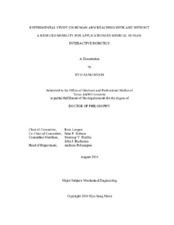| dc.description.abstract | Along with increasing advances in robotic technologies, there are now significant efforts under way to improve the quality of life especially those with physical disabilities or impairments. Control of such medical human-interactive robotics (HIR) involves complications in its design and control due to uncertain human factors. This dissertation makes its efforts to resolve three main challenges of an advanced HIR controller development: 1) detecting the operator’s motion intent, 2) understanding human motor behavior from the robotic perspective, and 3) generating reference motion for the HIR.
Our interests in such challenges are limited to the point-to-point reaching of the human arm for applications of their solutions in the control of rehabilitation exoskeletons, therapeutic haptic devices, and prosthetic arms.
In the context of human motion intent detection, a mobile motion capture system (MCS) enhanced with myoprocessors is developed to capture kinematics and dynamics of human arm in reaching movements. The developed MCS adopts wireless IMU (inertial measurement unit) sensors to capture ADL (activities of daily life) motions in the real-life environment. In addition, measured muscle activation patterns from selected muscle groups are converted into muscular force values by myoprocessors. This allows a reliable motion intent detection by quantify one of the most frequently used driving signal of the HIR, EMG (electromyography), in a standardized way.
In order to understand the human motor behavior from the robotic viewpoint, a computational model on reaching is required. Since such model can be constituted by experimental observations, this dissertation look into invariant motion features of reaching with and without elbow constraint condition to establish a foundation of the computational model.
The HIR should generate its reference motions by reflecting motor behavior of the natural human reaching. Though the accurate approximation of such behavior is critical, we also need to take into account the computational cost, especially for real-time applications such as the HIR control. In this manner, a higher order kinematic synthesis of mechanical linkage systems is adopted to approximate natural human hand profiles.
Finally, a novel control concept of a myo-prosthetic arm is proposed as an application of all findings and efforts made in this dissertation. | en |


